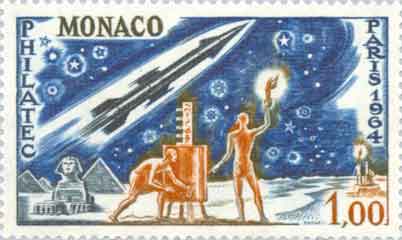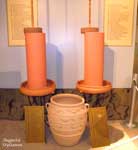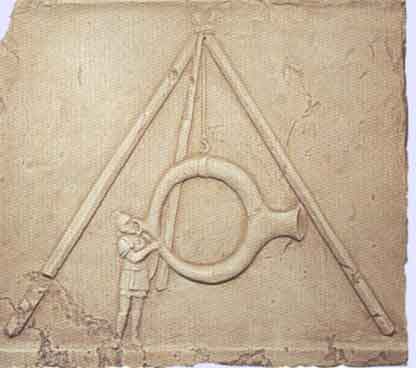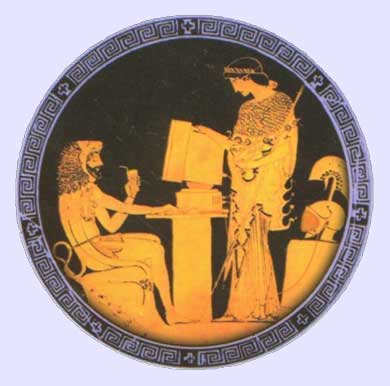.
Communication by fire (invented among many other things according to a legend by Palamedes) described in the Iliad.
Iliad Book 18
Then the lovely goddess
wrapped his head up in a golden cloud, so from him
a fiery light blazed out. Just like those times when smoke
from a city stretches all the way to heaven,
rising in the distance from an island under siege
by an enemy, where men fight all day long
in Ares' hateful war, struggling for their city—
then at sunset, they light fires one by one,
beacons flaming upwards to attract attention
from those on near-by islands, so their ships will come
to save them from destruction—that's how the light
blazed then from Achilles' head right up to heaven.
Aeschylus writes in Agamemnon that fire signals were used to send the message from Troy to the city Argos of the victory by the Greeks (1184 BC ?). Only after a few hours the message reached the c. 600 km distant city of Argos:
LEADER Say then, how long ago the city (Troy) fell?
CLYTEMNESTRA Even in this night that now brings forth the dawn.
LEADER Yet who so swift could speed the message here?
CLYTEMNESTRA From Ida's top Hephaestus, lord of fire, sent forth his sign; and on, and ever on, beacon to beacon sped the courier-flame. From Ida to the crag, that Hermes loves, of Lemnos; thence unto the steep sublime of Athos, throne of Zeus, the broad blaze flared. Thence, raised aloft to shoot across the sea, the moving light, rejoicing in its strength, sped from the pyre of pine, and urged its way, in golden glory, like some strange new sun, onward, and reached Macistus' watching heights. There, with no dull delay nor heedless sleep, the watcher sped the tidings on in turn, until the guard upon Messapius' peak saw the far flame gleam on Euripus' tide, and from the high-piled heap of withered furze lit the new sign and bade the message on. Then the strong light, far-flown and yet undimmed, shot thro' the sky above Asopus' plain, bright as the moon, and on Cithaeron's crag aroused another watch of flying fire. And there the sentinels no whit disowned, but sent redoubled on, the hest of flame swift shot the light, above Gorgopis' bay, to Aegiplanctus' mount, and bade the peak fail not the onward ordinance of fire. And like a long beard streaming in the wind, full-fed with fuel, roared and rose the blaze, and onward flaring, gleamed above the cape, beneath which shimmers the Saronic bay, and thence leapt light unto Arachne's peak, the mountain watch that looks upon our town. Thence to th' Atreides' roof-in lineage fair, a bright posterity of Ida's fire. So sped from stage to stage, fulfilled in turn, flame after flame, along the course ordained, and lo! the last to speed upon its way sights the end first, and glows unto the goal. And Troy is taken, and by this sign my lord.
The system of communication with fire from torches is called fryktories (φρυκτωρίες) from fryktos the torch and φρυκτωροί the persons who were responsible to observe and send the messages. Some have doubts whether it was possible to cover a 180 km distance with light from a fire from Athos to Macistus (except if the system was transmitted by a more complex system of fryktories).
Herodotus describe a firesignal sent from Sciathus (Skiathos) to Artemisium in 480 BC:
Herodotus 7.183:
When the Greeks stationed at Artemisium learnt what had happened by fire-signals from Sciathus, so terrified were they, that, quitting their anchorage-ground at Artemisium, and leaving scouts to watch the foe on the highlands of Euboea, they removed to Chalcis, intending to guard the Euripus.
A well know story is the messenger Philippides who was ordered to run to Athens to bring the news of the victory of Marathon. When he reached the agora, he gasped: nenikikamen, "We have won" and dropped dead. The modern Marathon race commemorates his feat.
Pigeons were also used by the Greeks to send messages such as the outcomes of the Olympic Games in ancient Greece, from 776 BC to Athens. Except these methods also more technical methods were used.
Polybius, a second century BC Greek historian, wrote about a communication and data encryption system. From other sources we know that such a device had been developed by Cleoxenus (Κλεόξενος o Μηχανικός) and Democleitus (Δημόκλειτος ο Εφευρέτης).

Communication ala Polybius
The most recent method, devised by Cleoxenus and Democleitus and perfected by myself, is quite definite and capable of dispatching with accuracy every kind of urgent message, but in practice it requires care and exact attention. It is as follows: We take the alphabet and divide it into five parts, each consisting of five letters. There is one letter less in the last division, but it makes no practical difference. Each of the two parties who are about to signal to each other must now get ready five tablets and write one division of the alphabet on each tablet, and then come to an agreement that the man who is going to signal is in the first place to raise two torches and wait until the other replies by doing the same. This is for the purpose of conveying to each other that they are both at attention. These torches having been lowered, the dispatcher of the message will now raise the first set of torches on the left side indicating which tablet is to be consulted, i.e., one torch if it is the first, two if it is the second, and so on. Next he will raise the second set on the right on the same principle to indicate what letter of the tablet the receiver should write down ... Upon their separating after coming to this understanding each of them must first have on the spot a ``viewing tube'' with two cylinders, so that with the one he can observe the space on the right of the man who is going to signal back and with the other that on the left. The tablets must be set straight up in order next the tubes, and there must be a screen before both spaces, as well the right as the left, ten feet in length and of the height of a man so that by this means the torches may be seen distinctly when raised and disappear when lowered. When all has been thus got ready on both sides, if the signaler wants to convey, for instance, that a hundred of the soldiers have deserted to the enemy, he must first of all choose words which will convey what he means in the smallest number of letters, e.g., instead of the above ``Cretans a hundred deserted us,'' for thus the letters are less than one half in number, but the same sense is conveyed. Having jotted this down on a writing-tablet he will communicate it by the torches as follows: The first letter is kappa. This being in the second division is on tablet number two, and, therefore, he must raise two torches on the left, so that the receiver may know that he has to consult the second tablet. He will now raise five torches on the right, to indicate that it is kappa, this being the fifth letter in the second division, and the receiver of the signal will note this down on his writing tablet. The dispatcher will then raise four torches on the left as rho belongs to the fourth division, and then two on the right, rho being the second letter in this division. The receiver writes down rho and so forth. This device enables any news to be definitely conveyed ... Many torches, of course, are required as the signal for each letter is a double one. But if all is properly prepared for the purpose, what is required can be done whichever system we follow. Those engaged in the work must have had proper practice, so that when it comes to putting it in action they may communicate with each other without the possibility of a mistake ... In offering these observations I am acting up to the promise I originally made at the outset of this work. For I stated that in our time all arts and sciences have so much advanced that knowledge of most of them may be said to have been reduced to a system. This is, then, one of the most useful parts of a history properly written.
The system was accurate but tedious. It can be considered in principle as an optical telegraph.

Communication methods in Egypt?

Hydraulic telegraph of Aeneas,
Aeneas of Stymphalus (known also as Aeneas Tacticus (Αινείας ο Τακτικός)), c. 350 BC, Greek military scientist and cryptographer from Arcadia. He invented an optical system for communication similar to a telegraph: the water-clocks.
The water-clocks are an early long-distance-communication-system. Every communicating party had exactly the same jar, with a same-size-hole that was closed and the same amount of water in it. In the jar was a stick with different messages written on. When one party wanted to tell something to the other it made a fire-sign. When the other answered, both of them opened the hole at the same time. And with the help of another fire-sign closed it again at the same time, too. In the end the water covered the stick until the point of the wanted message.
Polybius, in The Histories, Book X, describes:
The first person who we reliably know developed a telegraph was Aeneas Stymphalus. Aeneas was a well-known author in ancient Greece, who lived around 350 B.C. and wrote works on military strategy. Only part of his main work, "The Art of War", still exists, and unfortunately it does not contain the description of his telegraph. We do have a clear description of Aeneas's design by the historian Polybius (ca. 200-118 B.C.). In "The Histories" Polybius first described, in crystal-clear prose, the limitations of plain beacon fires.

Communication ala Aeneas, c. 350 BC
"I think that as regards the system of signaling by fire, which is now of the greatest possible service in war but was formerly underdeveloped, it will be of use not to pass it over but to give it a proper discussion. It is evident to all that in every matter, and especially in warfare, the power of acting at the right time contributes very much to the success of enterprises, and fire signals are the most efficient of all the devices which aid us to do this. For they show what has recently occurred and what is still in the course of being done, and by means of them anyone who cares to do so even if he is at a distance of three, four, or even more days' journey can be informed. So that it is always surprising how help can be brought be means of fire messages when the situation requires it. Now in former times, as fire signals were simple beacons, they were for the most part of little use to those who used them. For the service should have been performed by signals previously determined upon, and as facts are indefinite, most of them defied communication by fire signals. To take the case I just mentioned, it was possible for those who had agreed on this to convey information that a fleet had arrived at Oreus, Peparethus, or Chalcis, but when it came to some of the citizens having changed sides or having been guilty of treachery or a massacre having taken place in the town, or anything of the kind, things that often happen, but cannot all be foreseen--and it is chiefly unexpected occurrences which require instant consideration and help-- all such matters defied communication by fire signal. For it was quite impossible to have a pre-concerted code for things which there was no means of foretelling....
Aeneas, the author of the work on strategy, withing to find a remedy for the difficulty, advanced matters a little, but his device still fell far short of our requirements, as can be seen from his description of it. He says that those who are about to communication urgent news to each other by fire signal should procure two earthenware vessels of exactly the same width and depth, the depth being some three cubits and the width one. Then they should have corks made a little narrower than the mouths of the vessels [so that the cork slides through the neck and drops easily into the vessel] and through the middle of each cork should pass a rod graduated in equal section of three finger-breadths, each clearly marked off from the next. In each section should be written the most evident and ordinary events that occur in war, e.g., on the first, "Cavalry arrived in the country," on the second "Heavy infantry," on the third "Light-armed infantry," next "Infantry and cavalry," next "Ships," next "Corn," and so on until we have entered in all the sections the chief contingencies of which, at the present time, there is a reasonable probability in wartime. Next, he tells us to bore holes in both vessels of exactly the same size, so that they allow exactly the same escape. Then we are to fill the vessels with water and put on the corks with the rods in them and allow the water to flow through the two apertures. When this is done it is evident that, the conditions being precisely similar, in proportion as the water escapes the two corks will sink and the rods will disappear into the vessels. When by experiment it is seen that the rapidity of escape is in both cases the same, the vessels are to be conveyed to the places in which both parties are to look after the signals and deposited there. Now whenever any of the contingencies written on the rods occurs he tells us to raise a torch and to wait until the corresponding party raises another. When both the torches are clearly visible the signaler is to lower his torch and at once allow the water to escape through the aperture. Whenever, as the corks sink, the contingency you wish to communicate reaches the mouth of the vessel he tells the signaler to raise his torch and the receivers of the signal are to stop the aperture at once and to note which of the messages written on the rods is at the mouth of the vessel. This will be the message delivered, if the apparatus works at the same pace in both cases. "
The Roman historian Titus Livius (64 – 17) says that torch telegraphs as described by Polybius were used by Philip of Macedonia in his war against the Romans in 207:
From there, in order that he [Philip of Macedonia] might meet every movement of his enemies, he sent men into Phocis, Euboea and to Peparethus, to select heights from which signal fires might be visible. For himself he placed a watch-tower on Mountain Tisäon, whose peak rises to a great height, so that by fires on distant heights he might in an instant receive a message as to where his enemies were activ.
Signals were send vial sunlight via mirrors sometimes as simple as a shield:
On the fifth day as the Athenian ships sailed up, Lysander gave special instructions to the ships that were to follow them. As soon as they saw that the Athenians had disembarked and had scattered in various directions over the Chersonese--as they were now doing more freely every day, since they had to go a long way to get their food and were now actually contemptuous of Lysander for not coming out to fight--they were to sail back and to signal with a shield when they were half-way across the straits. These orders were carried out and as soon as he got the signal, Lysander ordered the fleet to sail at full speed. Thorax went with the fleet. When Conon saw that the enemy were attacking, he signaled to the Athenians to hurry back as fast as they could come to their ships. But they were scattered in all directions Xenophon, Hellenica, 405 BC
Using fire in the night and sunlight reflected by mirrors Greeks could send messages 40-100 or more kilometers, depending on the visibility. The method with the mirrors and the sun was called heliograph that means writing with the sunlight.
A simple method that was used also were colored flags to symbolize specific messages that were used also for a long time in the Navy.
In Alcibiades, The Lives of The Noble Grecians and Romans, by Plutarch ( 46-120), he referres to an event that took place in 410 BC:
Upon his first appearance, both sides formed a false impression; the enemy was encouraged and the Athenians terrified. But Alcibiades suddenly raised the Athenian ensign in the admiral ship, and fell upon those galleys of the Peloponnesians which had the advantage and were in pursuit.
A nice story is that many modern Greek telecommunication centers are often placed where the ancient Greeks used their communication systems showing that there positions was optimal selected.
Acoustic Signals
There Hera,
white-armed goddess, stood up, looking just like Stentor,
a great-hearted, loud-voiced man, whose voice could shout
with the strength of fifty men Homer Iliad

A a giant music instrument used by Alexander the Great to send acoustic signals probably that his army could hear from a distance of 5 km (some sources quote even 12 miles). The instrument is called a stentorophonic tube, from Stentor a figure of Greek Mythology
Cryptography (Crypto hidden, graphy writing )
The skytale or scytale, Spartan method and tool for encryption, around 400 BC. It consisted of a piece of wood and a leather-strip. Any communicating party needed exactly the same size wooden stick. The secret message was written on the leather-strip that was wound around the wood, unwound again and sent to the recipient by a messenger. The recipient would rewound the leather and by doing this enciphering the message.
The dispatch-scroll is of the following character. When the ephors send out an admiral or a general, they make two round pieces of wood exactly alike in length and thickness, so that each corresponds to the other in its dimensions, and keep one themselves, while they give the other to their envoy. These pieces of wood they call scytalae. Whenever, then, they wish to send some secret and important message, they make a scroll of parchment long and narrow, like a leathern strap, and wind it round their scytale, leaving no vacant space thereon, but covering its surface all round with the parchment. After doing this, they write what they wish on the parchment, just as it lies wrapped about the scytale; and when they have written their message, they take the parchment off and send it, without the piece of wood, to the commander. He, when he has received it, cannot otherwise get any meaning out of it,--since the letters have no connection, but are disarranged,--unless he takes his own scytale and winds the strip of parchment about it, so that, when its spiral course is restored perfectly, and that which follows is joined to that which precedes, he reads around the staff, and so discovers the continuity of the message. And the parchment, like the staff, is called scytale, as the thing measured bears the name of the measure. Plutarch, Lives (Lysander).

Communication using Shields
Herodotus, History Book 8, about the Persians
Nothing mortal travels so fast as these Persian messengers. The entire plan is a Persian invention; and this is the method of it. Along the whole line of road there are men (they say) stationed with horses, in number equal to the number of days which the journey takes, allowing a man and horse to each day; and these men will not be hindered from accomplishing at their best speed the distance which they have to go, either by snow, or rain, or heat, or by the darkness of night. The first rider delivers his despatch to the second and the second passes it to the third; and so it is borne from hand to hand along the whole line, like the light in the torch-race, which the Greeks celebrate to Vulcan. The Persians give the riding post in this manner, the name of “Angarum.”

Battle of Actium, Cleopatra 1963 Film, fictive scene, communication with mirrors.
Comments
from SCIENTIFIC AMERICAN SUPPLEMENT NO. 441 NEW YORK, JUNE 14, 1884:
Although the electric telegraph is, comparatively speaking, a recent invention, yet methods of communication at a distance, by means of signals, have probably existed in all ages and in all nations. There is reason to believe that among the Greeks a system of telegraphy was in use, as the burning of Troy was certainly known in Greece very soon after it happened, and before any person had returned from Troy. Polybius names the different instruments used by the ancients for communicating information—"pyrsia," because the signals were always made by means of fire lights. At first they communicated information of events in an imperfect manner, but a new method was invented by Cleoxenus, which was much improved by Polybius, as he himself informs us, and which may be described as follows:
Take the letters of the alphabet and arrange them on a board in five columns, each column containing five letters; then the man who signals would hold up with his left hand a number of torches which would represent the number of the column from which the letter is to be taken, and with his right hand a number of torches that will represent the particular letter in that column that is to be taken. It is thus easy to understand how the letters of a short sentence are communicated from station to station as far as required. This is the pyrsia or telegraph of Polybius.
References
J. J. M. Sleutels, WHAT IS COMMUNICATION? Paper presented at the annual euroActiv/Agfa meeting, Budapest, Nov. 26, 1999. Faculty of Philosophy, Leiden University, P.O. Box 9515, 2300 RA Leiden, Netherlands. jan@sleutels.com

Heracles reading e-mails
Dr. Howard Johnson, The Torches and the Hair
LINKS
E.N. Borza, "Alexander's Communications," in Proceedings of the 2nd International Symposium on Ancient Macedonia (Thessaloniki, 1977) 295-303. (PDF File)
Stephen R Llewelyn, Did the Ptolemaic postal System work to a timetable? PDF File
| Ancient Greece
Science, Technology , Medicine , Warfare, , Biographies , Life , Cities/Places/Maps , Arts , Literature , Philosophy ,Olympics, Mythology , History , Images Medieval Greece / Byzantine Empire Science, Technology, Arts, , Warfare , Literature, Biographies, Icons, History Modern Greece Cities, Islands, Regions, Fauna/Flora ,Biographies , History , Warfare, Science/Technology, Literature, Music , Arts , Film/Actors , Sport , Fashion --- |

